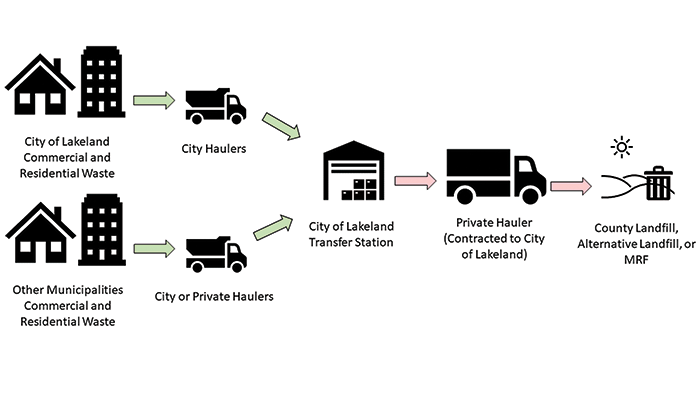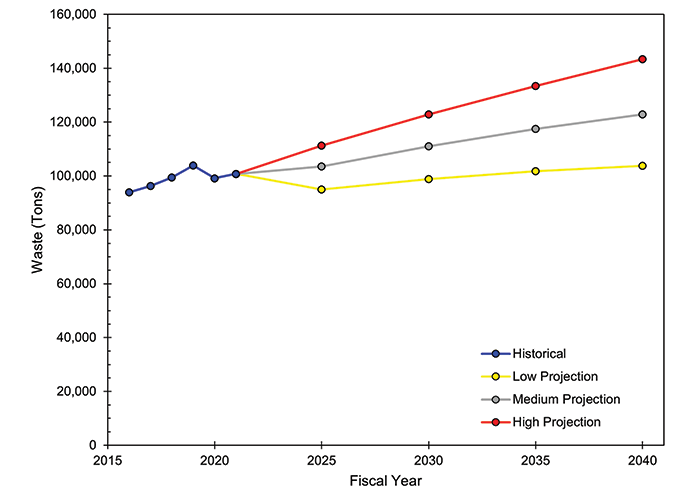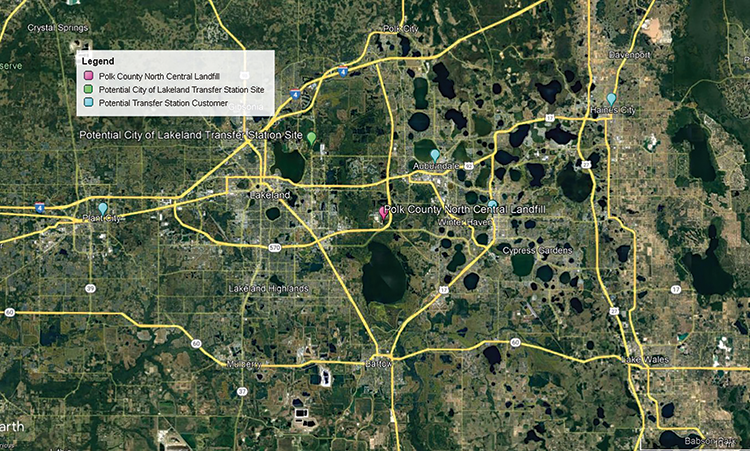Preparing a cost benefit report to consider the benefits and drawbacks of developing a solid waste transfer station in Lakeland, FL.
By Gene Ginn, Marc Rogoff, and Sarah Gustitus-Graham
The City of Lakeland, FL currently disposes solid waste at the Polk County North Central Landfill. In recent years, traffic delays and unnecessary wear to trucks unloading at the landfill have resulted in service difficulties and cost overruns for residential solid waste collection provided by Lakeland.
Continued growth of collection services within Lakeland could potentially worsen the issue in the future. Figure 1 graphically shows the operational concept of the proposed station. At the Lakeland’s request, Geosyntec Consultants, Inc. prepared a cost benefit report to consider the benefits and drawbacks of developing a solid waste transfer station in Lakeland. This article provides some guidance for other communities contemplating the development of a new transfer station.

Operational concept for proposed transfer station. Images courtesy of Geosyntec Consultants.
Overview of the Effort
Initially, Geosyntec gathered and reviewed information, including types of waste collected, number of routes, weight of waste collected, average time traveling to and from the disposal site, and idle time waiting to unload at the landfill. In addition, financial information, including wages (straight and overtime), operations and maintenance costs, and disposal costs for the Lakeland collection system was provided.
Thereafter, Geosyntec reviewed the existing sources and amounts of residential, commercial, and C&D waste streams that are managed within Lakeland and in nearby areas. This information was used to project future waste flows for the next 20 years (the design waste flow for the proposed transfer station) using available University of Florida Bureau of Economic and Business Research (BEBR) and City Department of Community and Economic Development population projections. As part of the waste flow review, Geosyntec also considered potential financial and operational requirements should third-party commercial or public entities also be allowed to use the proposed transfer station. From this review, a design capacity based on a probable flow of waste through the station was determined.

Based on the design capacity for the potential transfer station, Geosyntec developed concept-level estimates of construction and operating costs using data from similar Florida-based facilities. Using this information, a Pro Forma Model was developed, including four scenarios of varying costs and benefits that enable Lakeland to have preliminary, planning-level cost estimate. The Model projects annual costs to construct, operate, administer, and maintain the proposed transfer station, as well as provides a means for comparing alternative operational, institutional, and facility scenarios. Various assumptions are made regarding yearly solid waste quantities, demographic information, escalation factors for waste growth and costs, administration, personnel and utility costs, transportation costs, and landfill tipping fees. The costs of various programs and disposal options were estimated using published information on Lakeland’s solid waste system, repair costs for damages at a disposal facility, Geosyntec’s experience on
other similar projects, input from the private solid waste industry, other published information, and planning-level cost estimates prepared by Geosyntec. This Model was also used to determine a proposed tipping fee for use of the transfer station.
Transfer Station Sizing
At the outset of the project, the Division expressed an interest in a transfer station sizing scenario that would cover an anticipated 20-year life as well as have the capacity to process the MSW, recyclables, and yard waste generated in the City, some of which are now direct hauled to disposal or processing facilities in the County or outside the County. For this feasibility study, we assumed the use of an “open-top” loading system through a lift and load method, which is by far the most common type of transfer station design in the U.S. By doing so, this option would provide future flexibility for Lakeland to find alternative disposal or processing facilities for the various materials it collects at lower cost.
MSW that has been accepted will be processed using heavy equipment, such as a front-end loader, to push the waste into the open trailers or segregate recovered materials for future loading If mixed, recyclable materials will be amassed in separate stockpiles on the facility’s tipping floor.
Typically, for smaller-sized stations, the lift and load method, using a front-end loader for compaction, is the most cost effective. The principal features of the open-top system include the following:
• Scalehouse for weighing incoming and outgoing MSW or materials
• Concrete tipping floor on an elevated earth embankment
• Temporary floor storage of waste
• A metal building and interior concrete containment walls
• Trailer drive-through tunnels for loading
• Front-end loader
• Parking areas for employees, visitors, and transfer vehicles
• Buffer area for open space, landscaping, trees, berms, and walls that reduce impacts on neighbors
• Holding area for inspecting incoming loads and holding inappropriate waste loads or materials for removal
The city has negotiated with Lakeland Electric to reuse a 12-acre site for the transfer station location near its Electric Power Plant, which is now being transitioned from a coal ash pile to a viable transfer station site.
Figure 2 illustrates the total annual tons of residential and commercial MSW, recyclables, and yard waste collected in Lakeland. Actual tonnage records are shown for 2017 to 2021 with projections based on population growth for 2025 through 2040 (low, medium, and high growth BEBR projections). Based on these projections, the Division would need a transfer station sized to a volume of 500 tons per day over the 20-year time period.
Generators Outside the City of Lakeland
To gain economies of scale for overall operating costs, the CBA recommended that Lakeland should consider allowing the transfer station to service other nearby municipalities or private waste haulers located near the City of Lakeland, which comprise the potential “wasteshed” for the proposed transfer station (see Figure 3). Should this project be deemed feasible by the Lakeland City Commission, more detailed discussions would be necessary, including Memorandums of Understanding, terms of proposed agreements, and tipping fees.
The Pro Forma Model
As noted previously, the Model assumes that the projected operating costs for the station includes processing, transportation to the landfill, and debt service. Geosyntec included potential financial benefits of the proposed station to include avoided vehicle repairs at the landfill, truck purchase deferral, collection system efficiencies (the difference of going directly to the station and then back onto route rather than the turnaround at landfill back onto route), and customer tipping fees (projected station operating costs at the outset) assessed from non-City of Lakeland users (other municipalities and private haulers). It was assumed that the additional collection efficiencies from the station would enable the Division to defer one collection vehicle and driver and maintenance every four years.

The Model enabled us to calculate a Base Case and two other financial scenarios showing the projected benefit cost ratios (BCR) over the anticipated 20-year life of the station (Years 1, 10, and 20). The BCR was used to summarize the overall relationship between the relative costs and benefits of the proposed transfer station project. If a project has a BCR greater than 1.0, the project is expected to deliver a positive net present value to Lakeland. Alternatively, if a project’s BCR is less than 1.0, the project’s costs outweigh the benefits, and it should not be considered. Ultimately, the BCR was greater than 1.0 by 10 years post-construction for all but one of the scenarios considered for this project.
Lessons LearnedCost benefit analysis is the process of comparing the projected costs and benefits (or opportunities) to determine whether a project makes fiscal sense. If the projected benefits outweigh the costs, you could argue that the decision to execute the project is financially sound. This tool enabled city decision makers to evaluate the short- and long-term pros and cons of a major solid waste facility investment. Key lessons learned from this process include:
• Added scenarios allow for optimizing profit. Pro forma modeling assisted in evaluating the financial ramifications of various scenarios. For example, Geosyntec worked with the city to understand their different financing options and created models based on those choices.
• Consider other potential users. By considering scenarios with and without third-party haulers using the transfer station, we demonstrated that bringing in external hauling customers in the wasteshed (private or municipalities) could significantly increase the feasibility and profitability of the proposed transfer station.
• Look internally for siting options. Working with other city departments to find suitable city-owned parcels for the station removes several complications and unknowns out of the siting decision. Procuring city-owned land also improves the accuracy of projections when fluctuating land prices and the pressure of purchasing a suitable site do not have to be considered.
Status of Project
The study is currently under final review by the City Commission in April. Key stakeholders such as the City’s Finance, Public Works, and Electric Department have been consulted and a financing plan has been developed for the project. The city expects to move forward on the design and permitting in the near future. | WA
Marc J. Rogoff, PhD, is a Senior Consultant with Geosyntec Consultant’s Solid Waste Advisory Practice (Tampa, FL). He can be reached at (813) 810-5547 or e-mail [email protected].
Gene Ginn, MPA, is the Solid Waste Manager for the Public Works Department in the City of Lakeland, FL. He can be reached at (863) 834-8777 or e-mail [email protected]t.
Sarah Gustitus-Graham, EI, Ph.D, is a Professional at Geosyntec Consultants (Tampa, FL). She can be reached at (813) 379-4407 or e-mail s[email protected].
